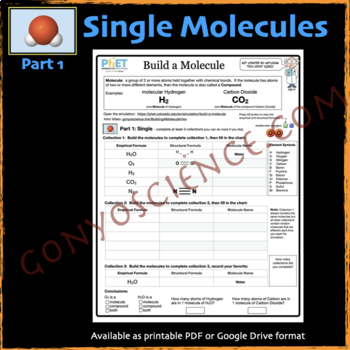PhET Build a Molecule activity guide
- Zip
- Google Apps™
- Easel Activity

What educators are saying
Also included in
- Now includes printable PDF, Google Slides, and TPT Easel versions!The PhET Chemistry Activity Guides are used along with the free *Next Generation PhET Simulations. All activity guides are in PDF and Google Slides formats and include an answer key and a Getting Started Guide for teachers.Your studenPrice $28.00Original Price $35.00Save $7.00
Description
Now in both printable PDF and Google Slides formats!
The PhET: Build a Molecule Activity Guide is used along with the free *Next Generation PhET Simulation on Build a Molecule. Students will experiment with combining atoms of different elements to discover new molecules.
Your students will hit the ground running without the need for a lengthy introduction from you. Just print the activity guide or share from your Google Drive. Students can watch the intro video and away they go. The best part is that students don’t even know they are learning, they just think they are having fun!
The activity guide takes students through all 3 parts of the simulation: Single, Multiple, and The Playground. Students will learn:
- the difference between Atoms, Molecules, and Compounds
- the significance of coefficient and subscript numbers in the empirical formula
- to construct molecular models given the molecular formula
- to draw structural formulas of molecules
- to determine the number of atoms of each element in a molecule
- to experiment to discover new molecules
The activity guide begins with a short introductory video to show students how the simulator works and includes both PDF and Google Slides versions for printing worksheets or sharing via Google Drive or Google Classroom. This lesson is perfect for face to face, hybrid, or remote learning!
This product includes the Intro video, Activity Guide (pdf), Activity Guide (Google Doc), Answer Key, and a Getting Started Guide for teachers.
*PhET simulations are fun, interactive, research-based simulations of physical phenomena. As students interact with the simulation, they get immediate feedback about the affects of the changes they made. All PhET simulations are freely available from the PhET website (phet.colorado.edu) and are easy to use and incorporate into the classroom. The new Next Generation sims utilize HTML 5 which allows them to run in any modern web browser on most devices including Chromebooks and tablets like the iPad! Learn more about using PhET Simulations with your students.







